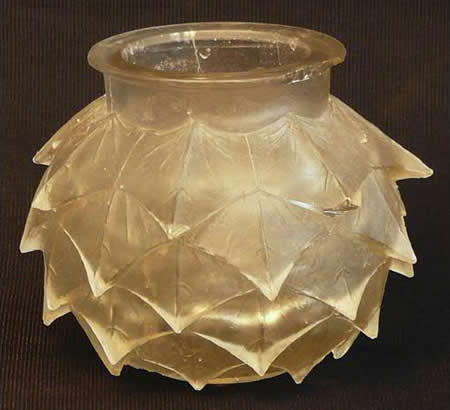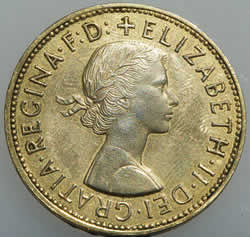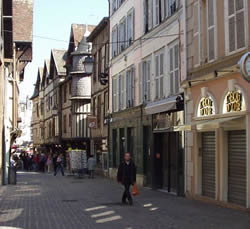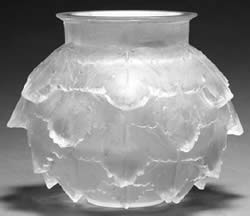
What place unites a Rene Lalique Cire Perdue Vase, old British Pounds, LaCoste clothing, Roman roads, medieval measuring, Thomas Jefferson, the French Revolution, and Peter the Great? Huh?
Here is a brief historical review!
Before the decimalization of the British currency in 1971, one British Pound Sterling equaled 20 Shillings composed of 12 Pence each, or a total of 240 Pence to the Pound. OK, you might be thinking, what does this have to do with a Lalique Cire Perdue Vase appearing in France? Well, we have to digress a bit.
 The historical origin of the old British currency was the fact that the weight of a British Penny was 1/240th of a Troy pound of sterling silver. This measuring system of the weight of a penny, or Pennyweight, which is abbreviated as dwt (the d in dwt stands for the old Roman silver coin Denarius) traces its origin to medieval times, and to this day a Troy Ounce contains 20 dwt. There being 12 Troy Ounces to an old Troy pound, that would make 240 dwt or pennies to the pound. And there you have a bit of the origin of the pre-decimal British currency; Troy pounds and Troy ounces!
The historical origin of the old British currency was the fact that the weight of a British Penny was 1/240th of a Troy pound of sterling silver. This measuring system of the weight of a penny, or Pennyweight, which is abbreviated as dwt (the d in dwt stands for the old Roman silver coin Denarius) traces its origin to medieval times, and to this day a Troy Ounce contains 20 dwt. There being 12 Troy Ounces to an old Troy pound, that would make 240 dwt or pennies to the pound. And there you have a bit of the origin of the pre-decimal British currency; Troy pounds and Troy ounces!
Now sadly, the Troy pound has fallen out of use* as a measurement factor, giving way to the globalization (before the term even existed) of currency units to the monetary equivalent of the library book organization system of Melvil Dewey (the Dewey Decimal System) wherein units of 100 are of prime importance. Monetarily, there are no countries left in the world that have not gone “currency decimal” **. If only Peter The Great had known what he was starting in 1710 when he set the value of a Russian Ruble at 100 Kopecks!
But while the Troy Pound has been tossed on the dust heap of history (the Troy Pound was booted in England in 1878), the Troy Ounce survives, mainly used today for measuring the weight of precious metals and gemstones. In the UK for example, the Troy Ounce measuring system is exempt from the wave of metrification that has swept away the old measuring systems on the islands. Apparently dentists and jewelers (and central bank types:) have some political pull in the UK!
 And why do we care even a “plugged nickel’s” *** worth about all this currency business? Because the namesake of the Troy measuring system is an old Roman crossroads town and trading center in northeastern France, about 100 miles from Paris, where the Troy measuring system had its earliest known use. The name of this small city which today is comprised of around 60,000 people? Troyes! What a coincidence! And it is there, dear readers, in the hometown of the great French alligator fashion house LaCoste, in Troyes France, that the Rene Lalique Cire Perdue Vase which is the subject of this story, has appeared!
And why do we care even a “plugged nickel’s” *** worth about all this currency business? Because the namesake of the Troy measuring system is an old Roman crossroads town and trading center in northeastern France, about 100 miles from Paris, where the Troy measuring system had its earliest known use. The name of this small city which today is comprised of around 60,000 people? Troyes! What a coincidence! And it is there, dear readers, in the hometown of the great French alligator fashion house LaCoste, in Troyes France, that the Rene Lalique Cire Perdue Vase which is the subject of this story, has appeared!
 One more short step backwards in time: In 1930, Rene Lalique created two similar Lalique Cire Perdue Vases in succession, CP 566 Feuilles De Lierre Dentelees, and CP 567, Feuilles De Lierre Pointues. Both these cire perdue vases were exhibited in October 1931 at Galarie Rouard in Paris. CP 566 appeared almost exactly 6 years ago, on November 24th, 2003 at the Tajan auction house in Paris. It was listed by Tajan as being 18 cm tall and it’s pictured here. It sold as Lot 3 in their sale for €73,403 all-in, several times the estimate of €20,000-€25,000. Note that in November 2003, €73,000 was around $100,000. It’s also rumored authoritatively that the runner-up bid on CP 566 was placed from a phone in the desert, just a few miles from RLalique.com World Headquarters!
One more short step backwards in time: In 1930, Rene Lalique created two similar Lalique Cire Perdue Vases in succession, CP 566 Feuilles De Lierre Dentelees, and CP 567, Feuilles De Lierre Pointues. Both these cire perdue vases were exhibited in October 1931 at Galarie Rouard in Paris. CP 566 appeared almost exactly 6 years ago, on November 24th, 2003 at the Tajan auction house in Paris. It was listed by Tajan as being 18 cm tall and it’s pictured here. It sold as Lot 3 in their sale for €73,403 all-in, several times the estimate of €20,000-€25,000. Note that in November 2003, €73,000 was around $100,000. It’s also rumored authoritatively that the runner-up bid on CP 566 was placed from a phone in the desert, just a few miles from RLalique.com World Headquarters!
CP 567, the pointed leafed mate of the softer designed CP 566 is the lalique cire perdue vase that is being offered in Troyes on November 22nd!
A bit worse for the wear, CP 567, shown in the large photo at the beginning of this article, has had a few hard knocks in life. It’s missing some pieces, including a large chunk of glass out of the top rim, and the ends of some leaves. And there are other miscellaneous condition issues. The vase is 17.2 cm tall, with comparable width, which gives it a decent scope as far as Lalique’s Cire Perdue is concerned. The estimate on this vase is only €2,000-€2,500 a mere 1/10 the estimate of its mate. The estimate seems a tad on the low side, even considering the extensive condition issues. But of course, if you are considering bidding, as always, you should investigate all relevant matters directly.
Might be a great opportunity to acquire a good sized piece of usually very expensive Cire Perdue glass for any collector wanting to at least have an example of Cire Perdue in their collection.
The seller of the vase is the auction house Boisseau & Pomez. Their phone number in Troyes is +33.03.25.73.34.07
Of course, this Lalique Cire Perdue Vase is listed in our Lalique at Auction section here at RLalique.com. And you can see other examples of Rene Lalique Cire Perdue by visiting our biography of Lalique, or by clicking on the Cire Perdue tag at the end of this article to see other articles relating to the Cire Perdue works of Rene Lalique.
* France was the third large country in the world to dump the Troy measuring system! After the 1710 Russian currency changes, it would be over 80 years until another large country followed suit when the Americans established their currency on a decimal basis in 1792 (the Thomas Jefferson thing). Three years later, in the turmoil of the French Revolution, France revamped its own currency to decimal format in 1795. It would be roughly another 80 years before the British in 1878, dumped what was in reality, a traditional French measuring system that had already been abandoned by the French!
** We’re ignoring the handful of countries that have increments of 1000 and not 100 (decimal on steroids?), and also the possible couple of countries with just one currency unit that is not divided by anything!
*** The expression “plugged nickel” originates in the American West in the late 1800’s (the Wild West era). It refers to the practice of extracting metal from coins by punching out a hole and then filling or plugging the hole with some worthless material so the coin could still be used (this from the days of course when coins actually contained valuable metals :). So a plugged nickel, being only a nickel to begin with, and not being even legal tender once defaced, would be worthless. The expression lives on to this day to denote something that has no value or is not worth anything. It’s the best we could do to work a monetary expression into to this story!
All Articles on These Topics: R Lalique Cire Perdue And Rene Lalique Cire Perdue, R Lalique Rene Lalique Auctions News and Results

